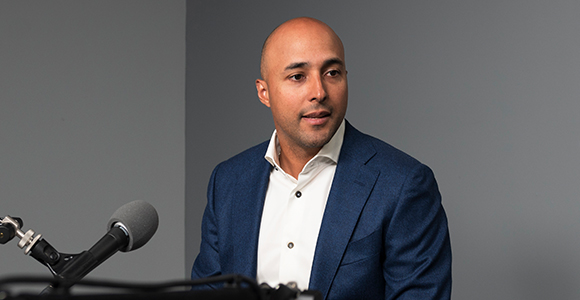How are rising interest rates impacting banks and housing markets?

Host: Amy Van Arnhem, Managing Director and Head of Canada Senior Relationship Management, TD Securities
Guest: Mario Mendonca, Managing Director and Senior Financial Services Analyst, TD Securities
Amy Van Arnhem talks with Mario Mendonca, Canada's leading analyst on financial institutions, about the movement in interest rates, what they mean for Canadian banks' future earning power, impact on the housing market and consumers.
Mortgages have been an important driver of bank ROEs. With low mortgage losses and strong growth for a long period, will rising interest rates turn off buyers and in turn affect bank results?
Listen to additional episodes for more perspectives from a variety of thought leaders on key themes influencing markets, industries and the global economy today.
NARRATOR: Welcome to Viewpoint, a TD Securities podcast. Listen in as we draw perspectives from a variety of thought leaders on key themes influencing markets, industries, and the global economy today. We hope you enjoy this episode.
AMY VAN ARNHEM: Hello, and welcome to episode 12 of Viewpoint, a TD Securities podcast. My name is Amy Van Arnhem. I'm a senior relationship manager at TD Securities, and I will be your host for today's episode. I'm joined by my colleague, Mario Mendonca, managing director, equity research.
Mario has been an analyst for 25 years, covering the financial services sector, including the Canadian banks. Mario is a top-rated financial services analyst in Canada, as rated by institutional investors in the most recent surveys. In the latest Brendan Wood survey, Mario was rated number one on banks and number one on insurers. Mario, thank you so much for joining me as we discuss the housing market in Canada and the implications for the Canadian banks.
MARIO MENDONCA: I'm happy to be here.
AMY VAN ARNHEM: To start off, could you speak to why housing and mortgages are so important to the Canadian banks?
MARIO MENDONCA: Yeah, our Canadian banks, unlike US banks, when a mortgage is underwritten, for the most part, it's kept on the balance sheet. It's not securitized or sold the way it's done in the US. In fact, mortgages on the-- let's just look at the Canadian balance sheet.
So ignoring their US operations, mortgages are close to 50% of all the loans. And that's an awfully big part of the picture. What's also, I think, important is although the margins on mortgages are somewhat lower than they would be on credit cards, the loss rates on mortgages are very low. And the capital ratio that be-- or rather the capital requirements on mortgages are relatively low.
And as a consequence, mortgages, I think, can be one of the more important drivers of bank ROEs. And I'd say mortgage losses have been low for so long, and mortgage growth has been strong for such a long period of time that it's been an important driver of our banks' higher ROEs, and it's important to note our banks generate ROEs that are as much as 400 to 500 basis points higher than their US peers.
And I think, in a very real way, the large mortgage market plays a role in driving that higher ROE for our Canadian banks, and higher ROE often leads to a higher valuation. And I think that's part of the picture, especially when you compare our Canadian banks to the US banks.
AMY VAN ARNHEM: Mario, could you also speak to some of the characteristics of our housing market, and the types of mortgages Canadians use, and how that differs to the US?
MARIO MENDONCA: Well, in Canada, the majority of mortgages are five-year fixed mortgages. Probably about a third of our mortgages would be variable mortgages as well. But the five-year fixed mortgage is a staple in Canada. In the US, they take a lot more-- the bank takes a lot more interest rate risk. They write 30-year mortgages.
And that's one of the reasons why US banks tend to securitize a significant amount of their mortgages. They don't want all that interest rate risk on their balance sheet. So that's the way to look at our Canadian banks. They've got probably 70% fixed-rate mortgages, 30% variable rate mortgages.
Five-year renewal periods are very, very common. And that really is an important attribute for our Canadian banks. It allows them to limit some of the interest rate risk associated with their mortgages. The five-year renewal is also very relevant because if you write a mortgage in year one, and interest rates change significantly from year one to year five, the mortgagee will find themselves with significantly different mortgage payments down the road.
And that's even true in the case of variable rate mortgages because in a case of a variable rate mortgage, your mortgage payment doesn't change-- in most circumstance, doesn't change until renewal. And that's become one of the really big issues that myself and other industry observers are trying to deal with right now. How do we look at the mortgage landscape in the context of materially higher interest rates? And that's, again, one of the big issues that I'm focused on right now.
AMY VAN ARNHEM: Well, coming to that, Mario, I've heard that a lot. And what are some of the risks that we should be aware of for the banks but also for the health of our consumers? As rates do move higher with these variable rate mortgages, what happens in terms of the servicing requirements for those mortgages, and what do we see in terms of some of the payments that Canadians could be faced with going forward?
MARIO MENDONCA: I'm going to discuss this in the context of variable rate mortgages, but this applies to a fixed rate mortgage at renewal as well. Let's think March 2020 and even throughout parts of 2021, when rates were much, much lower than they are right now. If you were fortunate enough to get into a variable rate mortgage then, you might have got into that mortgage at around 145 basis points, 150 basis points, so at 1.5%. That is a very, very low mortgage rate.
As rates rise, as they certainly have over the last year or so, your mortgage payment doesn't change. That, say, $2,000 monthly mortgage payment that you have will remain unchanged as rates move higher.
But something has to give. And what gives in that case is the amount of principal that your $2,000 mortgage payment is covering. Let's assume, just for simplicity, it was covering $1,000 of principal and $1,000 of interest.
As rates increase, what you'll find is that the mortgage payment, that same $2,000 mortgage payment is only covering, call it, $500 monthly of principal, and the other $1,500 is going toward the interest. You can certainly see a scenario where rates continue to rise to the point where the borrower, the borrower's payment, the $2,000 isn't covering anything but interest.
What you then, of course, will see is a period where the amortization, the remaining amortization of the mortgage, goes well beyond 35 years. And that's precisely what we saw when the banks reported their Q3 results. One of the most important things I was focused on as the banks reported, it was checking how much of their mortgages now have remaining amortization periods in excess of 35 years.
It's important to know that in the last couple of quarters, that number was low single digits. Call it 5%. It's now close to 20%. 20% of the banks' mortgages are now, have amortization periods of 35 years or more.
So what does all this mean? At some point when those mortgages mature, and then there are circumstances where it could happen sooner than the renewal date, but certainly at renewal, the mortgagee will find that their payment has to increase significant.
And we could be looking at increases in their mortgage payments of 30%, so that $2,000 becoming $2,600. That's a big number. And I don't think that investors and the banks have to worry about that here in the near term. In the near term, there could be some pressure on the marginal borrower.
The more important issue is 2025, 2026. And I picked those two years because that's about five years past the 2020 and the 2021 periods when mortgage rates were extremely low. So there is a risk here down the road that significant renewals of mortgages will play out, where the borrower's payment increases by more than a marginal amount.
And what I think we have to prepare for is that interest rates may not be this high in 2025 or 2026. So we don't know what the world will look like in a couple of years. We don't know whether mortgage payments will truly have to increase that much.
And in fact, one could argue that if this quantitative tightening that we're seeing right now results in a recession, it won't be long before we're cutting rates again. In fact, some economists are calling for central banks around the world to start cutting rates as early as mid to late 2023. So while I'm painting a picture of significantly higher mortgage payments coming down the pipe in 2025, '26, we really don't know. Mortgage rates could change significantly between now and then.
AMY VAN ARNHEM: And have you seen the banks action this in any way? So have they become stricter with approval conditions? Have they become less generous around appraisals or potentially more conservative around debt servicing requirements?
MARIO MENDONCA: Well, not really. Each time we ask a bank that question about any kind of change in their underwriting philosophy, most banks will say no, we like to underwrite with the same underwriting principles through the cycle. My inclination is that OSFI, the regulator for Canadian banks, will occasionally introduce underwriting standards that appear a little bit more strict.
I'll give you an example. The banks have had to stress test borrowers at a mortgage rate 200 basis points higher than the rate that they-- the bank was offering. So say a bank was offering a 2% mortgage. The borrower had to qualify for that mortgage under debt servicing ratios at about 4%.
That's the sort of thing that happens across the banking landscape. We tend to get changes in underwriting standards, but it's done more at the macro level by OSFI. The banks themselves, they may very well apply different types of standards and underwriting standards. It's not something that we see externally.
The closest thing to that is what I just described, where OSFI changes certain qualifying rules. Another thing that's sort of along the same lines is, as bank funding costs moves higher, and we're seeing wholesale funding costs and deposit costs increase for the banks, the banks have an important decision to make.
Will they increase rates significantly to protect that margin? Or will they let some of that business roll off the balance sheet because they don't think it's done at a particularly strong enough margin? I think that's a decision our banks will be making over the next little while. Protect the margin, or maybe give up some market share if they don't think that the margins are good enough. I think those are the considerations we'll see the banks put in place over the next little while.
AMY VAN ARNHEM: And as you mentioned in one of your earlier comments, we are coming off of Q3 results. So do you mind spending a little bit more time just sort of delving into what we saw in Q3? What did we see in terms of credit trends? Have the banks started to take additional provisions? And how they're thinking about consumer health and growth going forward.
MARIO MENDONCA: At the beginning of 2018, the banks had to put in place something called IFRS 9. IFRS 9 has the banks look at their performing loans. These are loans that are good. Nothing's wrong with them.
And they have to make an estimate as to the 12-month expected losses on those performing loans. And so the way you do that is you look at the health of the consumer, GDP growth, interest rates, housing starts, housing values. You look at all the macro factors-- inflation, unemployment, everything.
And you have to take, essentially, a guess at the extent to which those performing loans will result in losses over the next 12 months. And what we saw this quarter from the Canadian banks is that they put aside very little in the way of performing loan reserves. Now, they were already holding significant reserves from the past, but there were no-- there was very modest additional provisions that they booked on those performing loans.
So I'm not suggesting that our banks are perfect forecasters of future credit losses. There's not enough evidence for me to say that they are or they aren't because as I said, this standard only came about in 2018. But I do rely on the banks. I believe that the banks are better forecasters, and they have more information than the market at large.
And the banks themselves don't see significant new losses emerging on these performing loans. As I said, they're already holding strong reserves. But they didn't book a lot of new additional reserves this quarter. And that gives me some confidence that the banks aren't seeing a lot of problems on the horizon. I
Know the market, given where valuations are, the market certainly believes there are losses coming. But the banks themselves haven't started to book that. Other sort of related indicators that I care about are delinquencies. Are we seeing delinquencies start to rise? Not really.
There might be some modest movement delinquencies, but still very, very low. Gross Impaired Loan formations, or what we refer to as the GILs-- these are loans that in the quarter became impaired, where we become a little more concerned that that borrower may not be able to pay.
So gross impaired loan formations also remain low. That's the sort of thing I care about-- deposits. Like if deposits remain really healthy, and they have been, that also gives me some confidence that consumers have a lot of liquidity on hand.
Unemployment rates remain really low. I think the bottom line on credit is, I know very well that this very low level of credit losses, and I think credit losses right now are running at about half their normal level. I know very well that that's going to return to normal at some point. But there isn't an evidence to support the idea that we're going into a credit cycle yet.
I appreciate that the market has a different view right now. When our banks trade down to nine times forward earnings, which is where they're at right now, the market is clearly sending a signal that they believe there is a credit cycle coming. But based on what I've seen and what the banks have booked so far, it does not appear that one is coming in the year, in the near term.
So I still take the view that credit's going to normalize in 2022. We're going to go back to, say, 35 basis points of credit losses up from the 15 basis points we're seeing today. But I'm not building a credit cycle where our credit cycle would be loss rates of say 65, 75 basis points. I'm not there yet.
AMY VAN ARNHEM: And what would you need to see then, Mario, in the economy or in the health of the consumer or in terms of delinquencies in order for you to sort of start thinking through that maybe we are at the beginning of a credit cycle that is a little bit more worrisome than what you've got currently forecasted in your estimates?
MARIO MENDONCA: Yeah, payment trends on credit cards are sort of interesting. If people stop paying off their credit card balances on a more regular basis, that matters. Increases in delinquencies, gross impaired loan formations, an increase in unemployment, all the big macro pictures, those are the things that I really care about. And so far, they're just not there.
But yeah, it's the big macro pictures. I am sensitive to what we're seeing the Federal Reserve and the Bank of Canada doing. We had a lot of quantitative easing during the pandemic. It made sense.
The Fed balance sheet now is just $4 trillion larger than it was before the pandemic. That's intimidating to look at because as the Fed drains all that liquidity out of the market, we're going to see deposit balances start to shrink in the US and somewhat in Canada as well. So there certainly is a precursor to the losses emerging.
And those are the things I care about, the things I'll be looking at. I just haven't seen it. It hasn't had the effect yet. But no doubt, one of the things I'm really watchful of is, what is the Fed going to do in terms of that very, very large balance sheet?
How abruptly are they going to return that balance sheet back to the $4 trillion balance sheet we had before the pandemic? Because aggressive action by the Fed could create the recession that creates the big credit losses. We're just not there yet.
AMY VAN ARNHEM: So maybe taking this back to sort of where we started with housing market, is the price and sort of what we're seeing in terms of value, is that important to you? Are you watching that closely? Or is that something that will impact the banks' maybe future down the road as some of these mortgage terms start to renew?
MARIO MENDONCA: Interesting question. So housing values, does it matter? So remember that of our mortgages in Canada, probably a third, maybe even 40% are government-insured. So in theory, and just as a reminder to the listeners that if you're not able to put down at least 20% down payment when you buy a home, you have to get mortgage insurance. And about 30, maybe 40% of mortgages are government insurance.
So I'm not as sensitive to those. The other mortgages, the other, say, 60% to 65% of mortgages are uninsured mortgages. Now, in that case, that's a scenario where the borrower had more than 20% to put down.
So the loan-to-value is less than 80%. Housing values have gone straight up over the last few years. And I know more recently we've seen it check back. But the average loan-to-value for our Canadian banks and their mortgages is still extremely low.
And we're looking at loan-to-values of about 50%, 55%. Now I know the more recent mortgages, certainly the more recent mortgages, we wouldn't have loan-to-values of 55%. For the majority of mortgages out there, we're still looking at very low loan-to-value.
So the level of deterioration in housing prices to make me worry that the collateral would not be sufficient for the banks, it seems a little unlikely right now. We'd have to get far more deterioration in the value of homes to start threatening that loan-to-value. That's true in the case of mortgages that have been outstanding for a longer period of time.
Remember, two things happen-- the value of the house has gone up over time. And the debt has gone down as they've paid it down. So those two factors is what causes loan-to-values to decline so abruptly.
What I'm a little bit more sensitive to is the significant mortgage growth we saw in 2020 and 2021 because a lot of mortgages were added on the balance sheet then, and housing values are down. So it's really the most recent mortgages that were written that are going to cause the most headache. And I think the headache is 2025 and 2026, as we spoke about before. But for a significant majority of mortgages on the books, the loan-to-values remain extremely low.
AMY VAN ARNHEM: And are there any regions or geographical areas-- condos, single-family homes-- any characteristics in that regard that you're particularly watchful of?
MARIO MENDONCA: Not really. The condo and the housing-- and the single family housing market, there are periods when prices diverge. But for the most part, I don't try to make a big distinction there.
I do pay a lot of attention, however, to the growth that the banks report in Toronto and Vancouver. And some of our banks are very clear in providing disclosure for Toronto and Vancouver distinctly from the other parts of the country. And what you'll find is that a significant amount of mortgages are written in Toronto and Vancouver.
And I'm sensitive to that area because that's where we're likely to see the greatest housing price pressure. So far, what we've seen is that loan-to-values in those two regions remain pretty low. But no doubt, I think those are the two areas that-- Toronto and Vancouver, the two areas that I'm probably the most sensitive to, especially as we approach 2025 and 2026. But I don't make a very big distinction, say, between condos and single-family. Over the long term the trends tend to be very similar.
AMY VAN ARNHEM: Great. Well, look, this is a very important conversation, definitely for Canadians and for the Canadian banks. So thank you so much for joining us. And we'll keep a close eye on how things develop here.
MARIO MENDONCA: Thanks, Amy.
NARRATOR: Thank you for listening to Viewpoint, a TD Securities podcast. If you enjoyed this episode, subscribe to this series on Apple Podcasts or on your favorite podcast platform. For more thought leadership content, visit tdsecurities.com, and follow us on LinkedIn for all the latest TD Securities updates. For relevant disclaimers to this podcast, please refer to the Viewpoint episode page on our website.
This podcast should not be copied, distributed, published or reproduced, in whole or in part. The information contained in this recording was obtained from publicly available sources, has not been independently verified by TD Securities, may not be current, and TD Securities has no obligation to provide any updates or changes. All price references and market forecasts are as of the date of recording. The views and opinions expressed in this podcast are not necessarily those of TD Securities and may differ from the views and opinions of other departments or divisions of TD Securities and its affiliates. TD Securities is not providing any financial, economic, legal, accounting, or tax advice or recommendations in this podcast. The information contained in this podcast does not constitute investment advice or an offer to buy or sell securities or any other product and should not be relied upon to evaluate any potential transaction. Neither TD Securities nor any of its affiliates makes any representation or warranty, express or implied, as to the accuracy or completeness of the statements or any information contained in this podcast and any liability therefore (including in respect of direct, indirect or consequential loss or damage) is expressly disclaimed.

Amy Van Arnhem
Managing Director and Head of Canada Senior Relationship Management, TD Securities

Amy Van Arnhem
Managing Director and Head of Canada Senior Relationship Management, TD Securities

Amy Van Arnhem
Managing Director and Head of Canada Senior Relationship Management, TD Securities
Amy is responsible for providing holistic cross product global coverage to senior executives for Canadian institutional clients. In her role she manages stakeholder relationships by promoting a collaborative and integrated approach across the firm. Joining our firm in 2001, Amy began her career at TD in the retail sector. In 2007, she joined the Sales and Trading rotational program at TD Securities where she gained exposure in Asset Securitization, Proprietary Equity, and Institutional Equities. In 2008, she joined the Institutional Equity Sales desk team where she covered Canadian equity clients.

Mario Mendonca
Managing Director and Senior Financial Services Analyst, TD Securities

Mario Mendonca
Managing Director and Senior Financial Services Analyst, TD Securities

Mario Mendonca
Managing Director and Senior Financial Services Analyst, TD Securities
Mario joined TD Securities in October 2013 and covers the financial services industry. Mario is a top-rated Financial Services analyst in Canada as rated by institutional investors in the most recent surveys. In the latest Brendan Wood survey Mario was rated #1 on the banks and #1 on the insurers. In a previous Brendan Wood survey Mario was also rated Canada's Top Gun analyst. Prior to joining TD Securities, Mario was with Canaccord Genuity and Genuity Capital Markets where he worked with clients of different scales including medium to large sized firms, foreign, domestic, and public and mutual life insurance institutions. Mario started his career at Ernst & Young in the Financial Services Group, he later transitioned to CIBC World Markets as a Managing Director covering life insurance and mutual funds.




